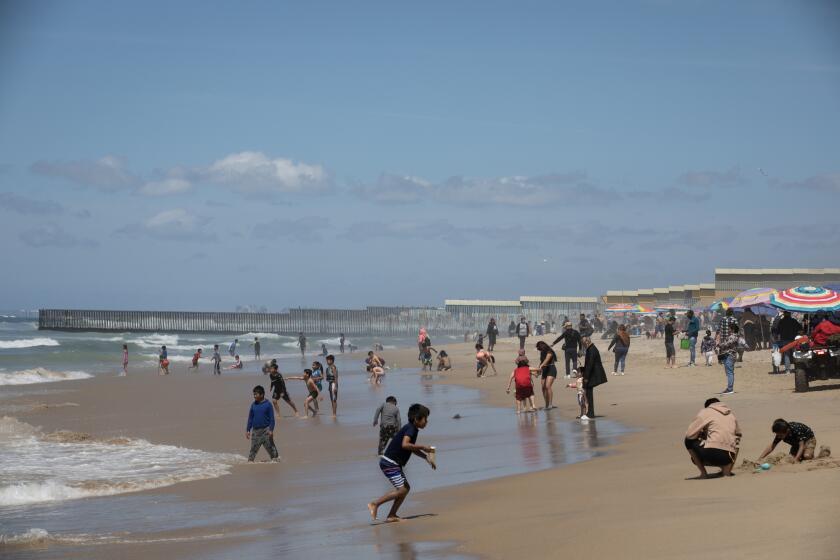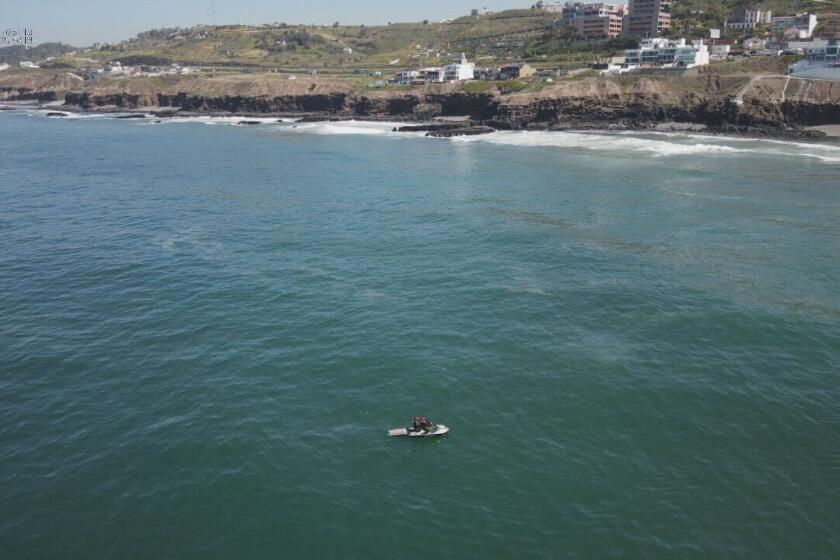Seeking asylum, Central American migrants await fate as they approach Tijuana border

Seeking asylum, Central American migrants await fate as they approach Tijuana border
Quick read:
- A caravan of Central American migrants is on its way to Tijuana.
- Some 200 members of the Pueblo Sin Fronteras caravan are preparing to ask for U.S. asylum.
- Many are Hondurans who say they are fleeing gangs who threaten to kill and extort them.
- Some from the caravan began arriving in Tijuana last week, mostly women and children, and began presenting themselves at the border.
- The caravan is arriving as Tijuana has seen a small but growing number of Central American migrants in recent months.
Full story
Just yards from the U.S. border, the Movimiento Juventud 2000 migrant shelter is typically filled with Mexicans deported from the United States. But in recent days, the modest single-story structure in Tijuana’s Zona Norte has been housing several dozen migrants fleeing violence and poverty in Central America.
“We’ll see what God says,” said Marisela Madrid, 29, of Choluma, Honduras, feeding a donut to her six-year-old son, Erik, shortly after arriving in Tijuana on Wednesday. Though exhausted after three days on a bus from Guadalajara, mother and child were preparing to leave early the next morning to the San Ysidro Port of Entry to ask for the U.S. government for asylum. “We hope they give us an opportunity.”
The migrants say they are members of the Pueblo Sin Fronteras Caravan, whose journey through Mexico in recent weeks has ignited the fury of President Donald Trump and drawn international attention.
Since launching on March 25 from the Mexican city of Tapachula on the Guatemalan border, the group has slowly been making its way across Mexico toward to the U.S. border. By Tuesday, the caravan is expected to reach its final destination,Tijuana — but it remains uncertain how many will be in the group.
In the early stages, the caravan’s number had grown to close to 2,000 participants, but by Wednesday had dwindled to about 600 — two-thirds of them women and children — as many peeled off on their own, said Irineo Mujica, a migrant advocate who is one of the group’s leaders.
Some members able to pay for bus fare — mostly women and children — went on ahead, and had already reached Tijuana last week. But the bulk of participants were riding the network of freight trains known as La Bestia, and on Thursday were in the port of Mazatlan in the Pacific Coast state of Sinaloa.
“We’re on the tracks of the train, and people are bringing us food,” Mujica said in a telephone interview. “This factor of Donald Trump has really made Mexicans come out and support the migrants.”
After meeting with legal advisers in the city of Puebla, some 200 caravan members are preparing to petition U.S. authorities for asylum, with another 100 or so “thinking about it,” Mujica said. The remainder are hoping to remain in Mexico with humanitarian visas promised by the Mexican government, he said.
Arduous journey, uncertain future
For those who reach Tijuana, much uncertainty lies ahead.
A 41-year-old house painter from the Caribbean port city of La Ceiba in northern Honduras, José Luis Eucedio Martínez said he fled after seeing his nephew killed for failing to pay a “war tax” to gang members. After spending a year in Tapachula, he said he was able to obtain legal residency in Mexico, and arrived in Tijuana earlier this month — hesitant of his next step.
Eucedio said he watched on Tuesday afternoon as a group of 85 Central Americans — including the spouse of a family member — presented themselves at the San Ysidro Port of Entry’s PedWest entrance to ask for asylum on Tuesday. He said Mexican immigration agents offered to show them the way, but instead guided them toward buses, where they were detained and driven to an immigration facility.
At the Juventud 2000 shelter, a 35-year-old Salvadoran woman on Wednesday said that she and her ten-year-old daughter had walked on their own to the port of entry earlier that day, intending to ask for asylum. An agent from the Mexican migrant protection unit, Grupo Beta, said there would be no more appointments for the day, and “said we should return tomorrow to try again.”
Immigration attorney Nicole Ramos said that a group of 11 migrants preparing to seek asylum reported being detained by Mexican immigration authorities on Thursday who told them their travel documents had expired. They were driven to an immigration station, where an official reviewed their documents and determined they had not expired. They were returned to the port and allowed to proceed, she said.
“I don’t see why any Mexican immigration official needs to review their paperwork, they’re already trying to leave the country,” Ramos said.
Mexican immigration authorities would not comment on the migrants’ accounts, citing federal electoral season rules that limit statements from public officials. But a Mexican federal official with knowledge of the situation, speaking on condition of anonymity, said Grupo Beta “is telling people that they should not be on the streets, especially with minors and they’re facilitating their transportation to shelters.”
It is the task of immigration enforcement agents to “take people who have no documents into custody, and take them to an immigration detention facility to evaluate whether or not they can legally stay in Mexico or not,” he said.
Members of the Pueblos Unidos caravan were issued exit documents in Oaxaca, and would not be subject to detention in Mexico, as long as the documents are not expired, the official said.
A small, but growing number of Central Americans at the California border
Central Americans have for many years have crossed Mexico in large numbers with the aim of making it to the United States, and the shortest and most traveled route takes them to the Texas border. But since 2015, a small but rising number of Central Americans have been finding their way to Tijuana.
The Central Americans “often come with a vague idea, not with a decisive strategy,” about crossing the border said Carlos Yee, program director at Tijuana’s Casa del Migrante. one of the city’s older and more established shelters. “What they know is that they need to leave Central America, and Tijuana is an option.”
In other areas of northern Mexico, such as Nuevo Laredo in the state of Tamaulipas, criminal groups systematically prey on migrants through extortion and kidnapping rings. While not free of danger, “many are seeing the possibility of crossing more safely in Tijuana,” said Yee.
In 2015, the Casa del Migrante saw 97 Hondurans, 52 Salvadorans and 65 Guatemalans. Last year, center’s statistics included 219 Hondurans, 177 Salvadorans, and 73 Guatemalans If current trends continue, the center anticipates a five-fold increase of Central Americans this year, Yee said.
Of three major migrant routes that lead through Mexico to the U.S. border, the one leading to Tijuana remains the least traveled, said Erick Cardona, Guatemala’s consul-general in Tijuana. He noticed a sharp drop in Guatemalan migrants border-wide in 2017, which he attributes to Trump’s inauguration, but said the numbers are climbing back up, and he expects this year’s flow to the border to exceed last year’s.
“Seeing that there is no clarity, they are once again embarking on the road to the American dream,” he said.
Caravans send message
The caravan has been a yearly tradition for Pueblo Sin Fronteras since 2010 — a way of drawing attention to the plight of undocumented Central American migrants who are vulnerable to being preyed upon both by criminals and corrupt officials.
Mujica said this year’s group has been the largest, with more than 80 percent of participants from Honduras, where many say they are fleeing gang violence and instability following the highly questioned re-election of the country’s president.
President Trump became infuriated after learning of the Caravan earlier this month, accusing Mexican authorities of doing nothing to stop the flow of migrants through its southern border. In a series of tweets, he threatened to end negotiations over the North American Free Trade Agreement and eliminate the DACA program that allows young undocumented immigrants brought over as children to remain the United States.
But Mexican government statistics tell a different story: Last year, more than 76,000 Central Americans were deported by Mexican authorities, the greatest numbers to Guatemala and Honduras. In the first two months of this year, more than 16,000 Central Americans were deported, according to Mexico’s National Migration Institute.
Safe haven in Tijuana
Seven years ago, Jose Aguilar, 41, was a taxi driver in the northern Honduran city of San Pedro Sula when he decided to leave. Gang members had murdered his brother, and while Aguilar said that he had not been threatened, he saw much violence all around, and little hope for the future.
So Aguilar took his chances to join another brother in Tijuana, who worked in the used car business, and made plans to go to the United States. “I was intending to cross, but the truth is, it was very difficult back then, not to mention how it is now,” Aguilar said. “I never tried it, just hearing the prices, I thought, ‘No, it’s too difficult’.”
Three years ago, Aguilar opened Honduras 504, a small restaurant in Tijuana’s Zona Norte that serves typical Honduran dishes such as pollo con tajadas — fried chicken with fried banana slices, or mondongo soup of slow-cooked vegetables.
Without a Honduran Consulate in Tijuana, the restaurant has become an unofficial gathering place for many of his countrymen arriving at the border. Aguilar has seen their numbers increasing over the past year. “They’re people who had businesses, small shops, and the extortionists would no longer let them work,” he said.
Aguilar said Tijuana has treated him well: He is now married, with a son, and has become a legal Mexican resident. “Nobody is extorting us, we don’t have to worry about someone showing up with a pistol to threaten us,” he said. “It’s the Mexican dream, we’re working hard, getting opportunities we couldn’t get in Honduras.”
Get Essential San Diego, weekday mornings
Get top headlines from the Union-Tribune in your inbox weekday mornings, including top news, local, sports, business, entertainment and opinion.
You may occasionally receive promotional content from the San Diego Union-Tribune.



